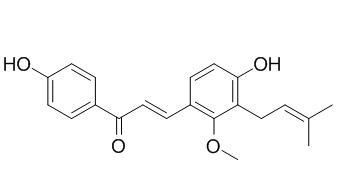Licochalcone C
Licochalcone C has cardioprotection effect, via antioxidant, anti-inflammatory, and anti-apoptotic activities; it shows inhibition of bacterial growth and cellular respiration. Licochalcone C exhibits inhibitory activity with cytotoxicity in a rat basophilic leukemia cell line, RBL-2H3. It induces apoptosis via B-cell lymphoma 2 family proteins in T24 cells, it may be a potential adjuvant therapeutic agent for bladder cancer.
Inquire / Order:
manager@chemfaces.com
Technical Inquiries:
service@chemfaces.com
Tel:
+86-27-84237783
Fax:
+86-27-84254680
Address:
1 Building, No. 83, CheCheng Rd., Wuhan Economic and Technological Development Zone, Wuhan, Hubei 430056, PRC
Providing storage is as stated on the product vial and the vial is kept tightly sealed, the product can be stored for up to
24 months(2-8C).
Wherever possible, you should prepare and use solutions on the same day. However, if you need to make up stock solutions in advance, we recommend that you store the solution as aliquots in tightly sealed vials at -20C. Generally, these will be useable for up to two weeks. Before use, and prior to opening the vial we recommend that you allow your product to equilibrate to room temperature for at least 1 hour.
Need more advice on solubility, usage and handling? Please email to: service@chemfaces.com
The packaging of the product may have turned upside down during transportation, resulting in the natural compounds adhering to the neck or cap of the vial. take the vial out of its packaging and gently shake to let the compounds fall to the bottom of the vial. for liquid products, centrifuge at 200-500 RPM to gather the liquid at the bottom of the vial. try to avoid loss or contamination during handling.
Phytomedicine2022, 104:154318
Int Immunopharmacol.2024, 143(Pt 2):113486.
Asian Journal of Chemistry2014, 26(22):7811-7816
Food Chem.2017, 228:301-314
Molecules2022, 27(11):3606.
Front Nutr.2024, 11:1507886
J Sci Food Agric.2018, 98(3):1153-1161
Applied Biological Chemistry2023, 66:8
Chinese Medicine2019, 14(1)
Molecules.2023, 28(18):6734.
Related and Featured Products
Arch Pharm Res. 2013 Dec;36(12):1432-6.
Concise synthesis of licochalcone C and its regioisomer, licochalcone H.[Pubmed:
23897165]
Licochalone C (7a) is a retrochalcone isolated from Glycyrrhiza inflata, which shows potent antioxidant properties and inhibition of bacterial growth and cellular respiration.
METHODS AND RESULTS:
Biological studies have suggested that Licochalcone C attenuates the lipopolysaccharide and interferon-gamma induced inflammatory response by decreasing the expression and activity of inducible nitric oxide synthase and modulating the antioxidant network activity of superoxide dismutase, catalase, and glutathione peroxidase activity. Licochalcone C also inhibits NADH-cytochrome C reductase in the membrane fraction of Micrococcus luteus.
CONCLUSIONS:
Since pharmacological activity studies of Licochalcone C are ongoing and the yield of the compound is poor from natural product, we report a concise four step synthesis of Licochalcone C (7a) and its regioisomer, tentatively called licochalcone H (7b), by employing acid-mediated Claisen-Schmidt condensation as a key step with 6 and 20 % overall yield, respectively.
Life Sci. 2015 Apr 25. pii: S0024-3205(15)00228-3.
Role of licochalcone C in cardioprotection against ischemia/reperfusion injury of isolated rat heart via antioxidant, anti-inflammatory, and anti-apoptotic activities.[Pubmed:
25921769]
This study aimed to evaluate the protective effect of Licochalcone C against myocardial ischemia/reperfusion injury in rats.
METHODS AND RESULTS:
Left ventricular developed pressure (LVDP) and its maximum up/down rate (±dp/dtmax) were recorded as myocardial function. Pretreatment with Licochalcone C significantly improved the recovery of LVDP and ±dp/dtmax, and increased the levels of SOD and GSH/GSSG ratio. However, pretreatment with Licochalcone C not only decreased the TUNEL-positive cell ratio and morphological changes, but also weaken the mitochondrial injury and the levels of CK, LDH, MDA, and TNF-α.
CONCLUSIONS:
These results suggested an important function of Licochalcone C extracted from traditional Chinese medicine in the cardioprotection via antioxidant, anti-inflammatory, and anti-apoptotic activities.
Int Immunopharmacol. 2010 Jul;10(7):769-76.
Licochalcones suppress degranulation by decreasing the intracellular Ca2+ level and tyrosine phosphorylation of ERK in RBL-2H3 cells.[Pubmed:
20399908 ]
Mast cells play a key role in allergic inflammation by releasing various mediators, such as histamine, serotonin, leukotrienes and cytokines.
METHODS AND RESULTS:
A signaling cascade of events activated by stimulation with antigens contributes to the regulation of mast cell degranulation. While various anti-inflammatory and anti-allergic drugs have been developed that inhibit degranulation of mast cells, the inhibitory mechanism has been poorly understood. Licochalcone A (Lico A) is a retrochalcone isolated from the root of Xinjiang liquorice and has been reported to exhibit various biological activities such as anti-inflammatory activity. We examined the effects of Lico A and related chalcones on degranulation in a rat basophilic leukemia cell line, RBL-2H3. Whereas Lico A and Licochalcone C (Lico C) exhibited inhibitory activity with cytotoxicity, licochalcone D (Lico D) significantly inhibited the degranulation in RBL-2H3 cells with low cytotoxicity. Moreover, Lico D significantly inhibited the Ca2+ influx and phosphorylation of extracellular signal regulated kinase (ERK) and MEK.
CONCLUSIONS:
These results suggest that Lico D inhibits mast cell degranulation via the inhibition of both extracellular Ca2+ influx and activation of the MEK-ERK pathway.
Mol Med Rep. 2015 Nov;12(5):7623-8.
Licochalcone C induces apoptosis via B-cell lymphoma 2 family proteins in T24 cells.[Pubmed:
26397392 ]
The current study investigated the mechanisms by which Licochalcone C induces apoptosis of T24 human malignant bladder cancer cells.
METHODS AND RESULTS:
Cell viability was evaluated using an MTT assay. Apoptosis was investigated using a morphological assay, flow cytometry and a caspase‑3 activity assay. Alterations in the gene expression levels of Bcl‑2 family members were measured by semi‑quantitative reverse transcription‑polymerase chain reaction assays. The protein levels of pro‑caspase‑3 and cleaved poly(ADP ribose) polymerase were measured using western blotting.
The results indicated that Licochalcone C induced T24 cell apoptosis in a concentration‑dependent manner. Licochalcone C treatment reduced the levels of the anti‑apoptotic mRNAs (Bcl‑2, Bcl‑w and Bcl‑XL) and increased expression of the pro‑apoptotic mRNAs (Bax and Bim). The Bcl‑2 family inhibitor (ABT‑737) reduced apoptosis induced by Licochalcone C in T24 cells.
CONCLUSIONS:
The current study demonstrated that Licochalcone C may be a potential adjuvant therapeutic agent for bladder cancer.



